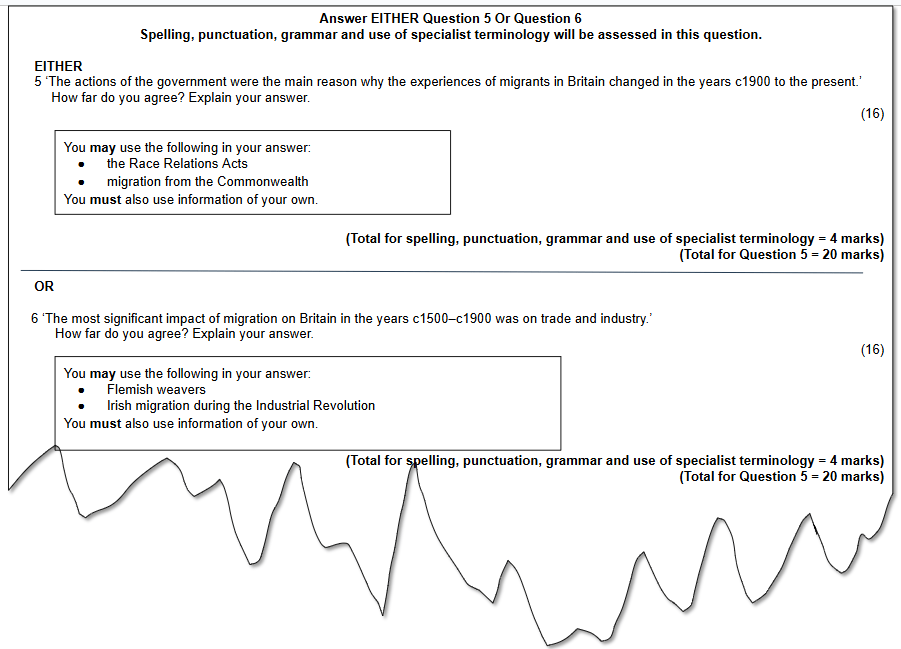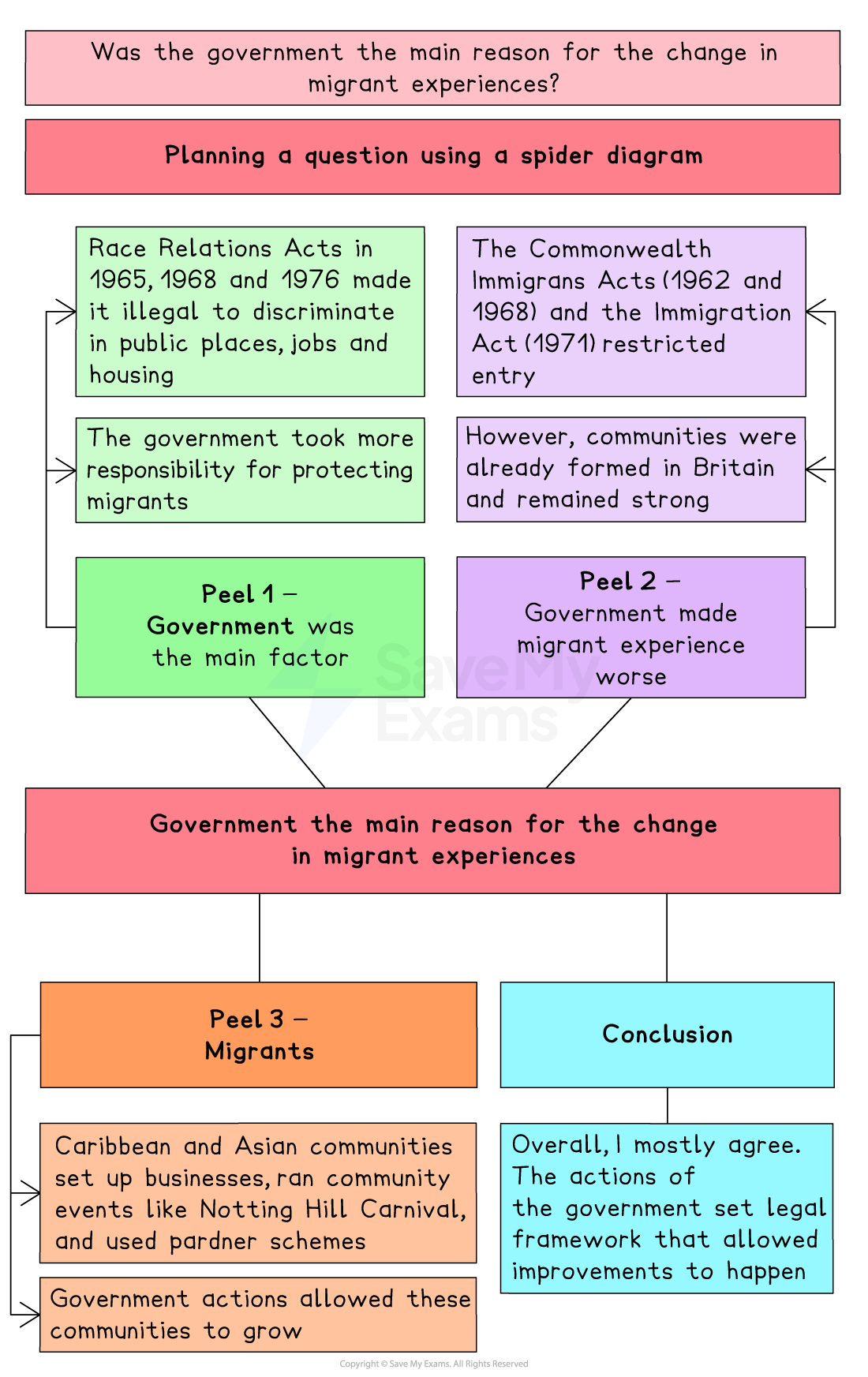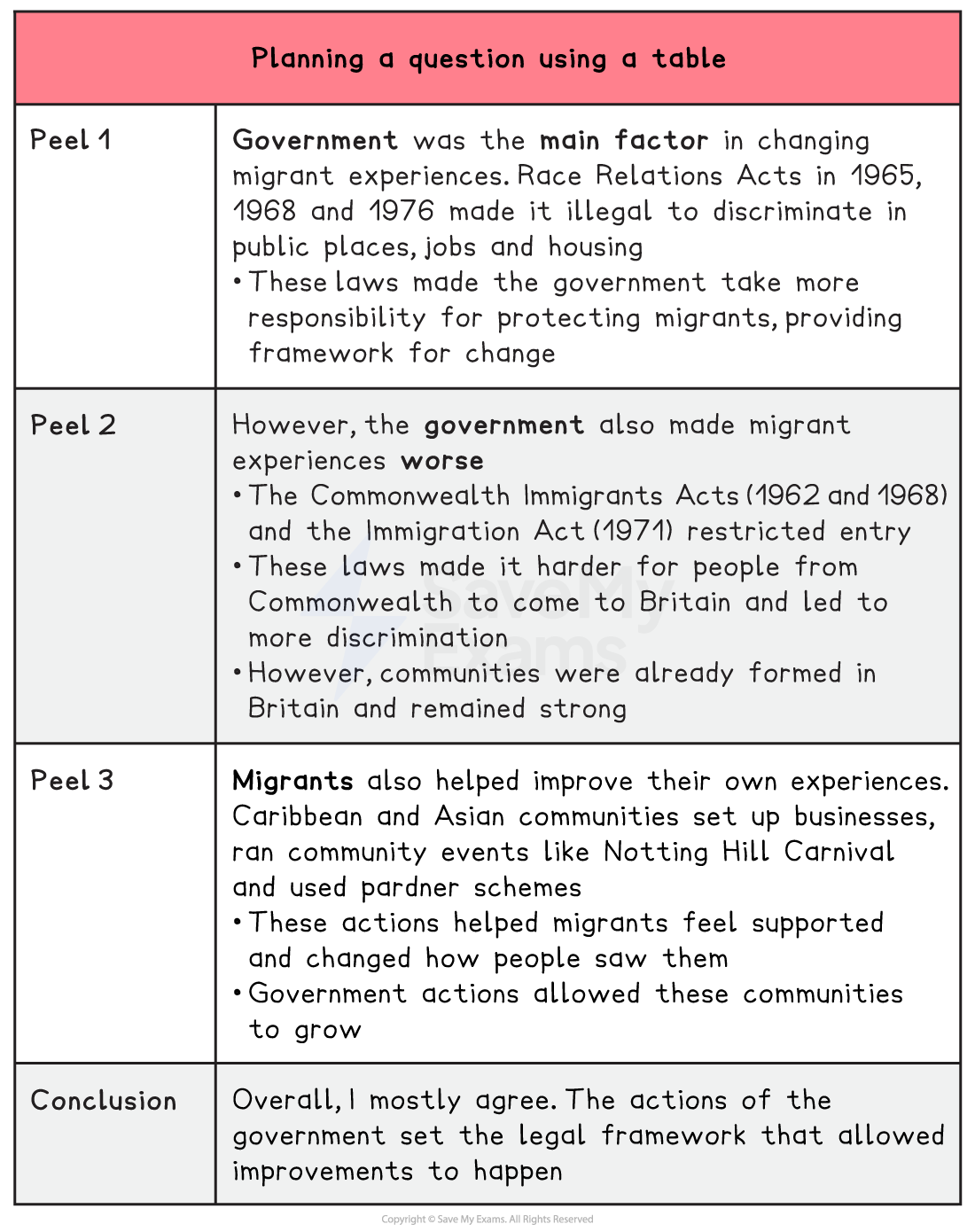The 16 Mark "How Far do you Agree" Question (Edexcel GCSE History): Revision Note
Exam code: 1HI0
Summary of Question 5 or 6
You will choose either Question 5 or Question 6
Answering either question requires you to:
Make a clear, sustained judgement about a historical statement
Use second-order concepts such as cause, change, significance or consequence
Compare the given reason with other valid reasons
Reach a well-structured conclusion
From the 2025 exams onwards, the question will cover either a complete period or at least 200 years
Amount of marks | 16 + 4 SPaG marks |
|---|---|
The time that you should spend on the question | 5 minutes of planning 20 minutes of writing |
An example of the type of question you may encounter can be seen below:

In previous years, this question has focused on the following topics in Migrants in Britain:
Year of Exam | Question Topic |
|---|---|
2022 (opens in a new tab) | Question 5: The positive experiences of migrants, c1500–c1700 Question 6: The British Empire was the main reason for migration, c1700–c1900 |
2023 (opens in a new tab) | Question 5: Changes in British society were the main reason migration increased, c1500–c1900 Question 6: Migrants' impact on the economy, c1700–present |
2024 | Question 5: Migrants' impact on trade, c800–c1500 Question 6: Safety from religious persecution as a reason for migration, c1500–c1700 |
Making judgements in history
The 16-mark question requires you to weigh all the evidence and make a decision
Students often find this part the hardest to do
Common mistakes in judgement questions
Explaining that all of the reasons are the most important
Avoiding a clear decision by using phrases such as “kind of” or “maybe”
Giving no opinion
Changing your argument halfway through
In the example question, you state that the government was the main reason migrant experiences changed
However, in the conclusion, you state that attitudes in society were the main reason
Doing this means that there is no sustained judgement, and you cannot access Level 4 (13–16 marks)
What makes a good judgement?
Clearly answer the question clearly using second-order concepts
Acknowledge other sides of the argument
Have a consistent judgement from start to finish
Use your best evidence to back up your decision
There is no "right" or "wrong" answer in history
Consider other reasons
Even if you fully believe a reason is the most important, you still need to present evidence for other reasons
What makes a great conclusion in GCSE History?
Conclusions are usually where most of your judgement marks will be awarded
All great conclusions have these three elements:
Judgement — State your opinion using words from the question
Counter — Mention a reason from the other side
Support — Use your strongest evidence to explain why your side is more convincing
How to get SPaG marks
In Paper 1, students have access to an additional 4 marks for answering either Question 5 or Question 6
This is awarded for SPaG ( Spelling, Punctuation and Grammar)
SPaG mark | Reason for this mark |
|---|---|
0 |
|
1 |
|
2–3 |
|
4 |
|
Top tips for boosting SPaG marks
Spell historical terms correctly
Use paragraphs
Re-read your work to check punctuation
Reading the answer in your head
Where you would take a breath, make sure there is a comma or a full stop
How to answer a "How far do you agree?" question
In the exam, only answer either Question 5 or Question 6
You should put an "X" in the box next to the question you have chosen to answer

You will receive two stimulus points
These are areas of knowledge to discuss in your question
If you only discuss these two stimulus points, you are limited to a maximum of 11 marks
You can choose not to use any of the suggestions
You can still achieve full marks by not using the two stimulus points
You must discuss three areas of knowledge in your answer to access Level 4
To answer this question successfully, you should:
Read the answer carefully and multiple times
Annotate the question to find the key demands of the question
Plan your answer, including:
What your judgement is
The key knowledge you wish to use


"How far do you agree?" question structure
Your answer should include:
A logical structure
A range of specific and relevant knowledge
An explanation of the second-order concept outlined in the question
A clear and sustained judgement throughout the answer
A conclusion
If you want to include an introduction, you can, but it is not necessary
Your answers could be written in PEEL paragraphs:
P — Make a point about the question
This should include your judgement
E — Use evidence that supports the point that you have made (K)
Evidence needs to be relevant and specific to the question
E — Explain why this evidence supports your point
Your explanation should be focused on the second-order concept outlined in the question (SOC)
L — Link your explanation back to the question to help sustain your argument and show your understanding of the question
The question is out of 20 marks:
6 marks for a wide range of specific knowledge of the period and the topic stated in the question (K)
10 marks for the analysis of the key second-order concepts of cause and consequence, similarities and differences, and importance (SOC)
4 marks are awarded for Spelling, Punctuation and Grammar (SPaG)
Worked example of a "How far do you agree?" question
Worked Example
"The actions of the government were the main reason why the experiences of migrants in Britain changed in the years c1900 to the present."
How far do you agree? Explain your answer.
(16 + 4SPaG)
You may use the following in your answer:
You must also use information of your own. |
Answer
I agree that government actions were a very important reason why migrant experiences changed from c1900 to the present. However, other reasons, such as the impact of migrant communities themselves and changing public attitudes, also played a key role.
One reason why the government changed migrant experiences was through laws such as the Race Relations Acts. These made it illegal to discriminate in public places (1965), at work (1968) and in housing (1976) (K). These laws aimed to improve the treatment of migrants and encourage a more equal society. They marked a turning point when the government took more responsibility for protecting migrants from unfair treatment. Therefore, although racism didn’t disappear, these laws changed the rights that migrants had in British society (SOC).
Another way the government shaped migrant experience was through controlling who could enter Britain. After lots of people came from the Commonwealth in the 1950s and 1960s, new laws such as the Commonwealth Immigrants Acts (1962 and 1968) and the Immigration Act 1971 made it harder for non-white migrants to settle in Britain (K). These laws were a response to pressure from some British people and showed that government actions could also make migrant experiences harder. However, migration laws before the 1960s had accepted migrants into British society, allowing communities to thrive. This meant that, despite these actions, migrant experiences were still improving due to these strong communities (SOC).
However, the experiences of migrants also changed because of the efforts made by migrants themselves. Caribbean and Asian migrants built strong communities, set up businesses, supported each other with "pardner" schemes and organised cultural events such as the Notting Hill Carnival (K). These actions helped migrants feel safer and more connected in Britain. Over time, these communities helped change the image of migrants and contributed to British culture. However, government actions in the 1940s and 1950s allowed these communities to establish themselves in Britain, creating the foundations for them to grow (SOC).
Overall, I mostly agree that the actions of the government were a major reason why migrant experiences changed, and the government caused change by passing important laws that improved rights and protection (SOC). Although migrant communities played a big role by creating support networks, organising events and helping to change attitudes, the government’s actions had the biggest impact. Laws such as the Race Relations Acts made it illegal to discriminate and gave migrants proper rights for the first time. This shows how government actions were the key cause of change (SOC).

Unlock more, it's free!
Did this page help you?